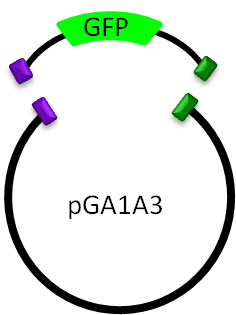Team:Washington/Protocols/pGA
From 2011.igem.org
(→Gibson assembly efficiency assay) |
(→Gibson assembly efficiency assay) |
||
| Line 3: | Line 3: | ||
=Gibson assembly efficiency assay= | =Gibson assembly efficiency assay= | ||
| + | |||
| + | === PCR === | ||
| + | |||
| + | The PCR reactions were conducted with 2x Phusion Flash polymerase master mix, 1 ng plasmid template, and 0.5 μM of each primer. | ||
| + | |||
| + | For the pGA assay, the insert came from a pGA1C3 vector and the insert came from a pGA1A3 vector expressing GFP. We used primers pGAprefix_fwd and pGAsuffix_rev to amplify the insert, and pGAsuffix_fwd and pGAprefix_rev to amplify the backbone. | ||
| + | |||
| + | For the pSB assay, the insert came from a pSB3K3 vector and the insert came from a pSB1A3 vector expressing low GFP levels that are not strong enough to see visually. We used Biobrick primers [http://partsregistry.org/wiki/index.php?title=Part:BBa_G1004 BioBrick_f] and [[http://partsregistry.org/wiki/index.php?title=Part:BBa_G1005 BioBrick_r]][http://partsregistry.org/wiki/index.php?title=Part:BBa_G1000 Suffix_f] and [[http://partsregistry.org/wiki/index.php?title=Part:BBa_G1001 Prefix_r]] to amplify the backbone. | ||
| + | |||
| + | === Gibson reactions === | ||
| + | |||
| + | Starting with each | ||
For each of the Gibson reactions, we added 20ng of gel-extracted PCR products for the inserts and backbones. For the pSB assay we used the primers for the inserts and () primers for the backbone. | For each of the Gibson reactions, we added 20ng of gel-extracted PCR products for the inserts and backbones. For the pSB assay we used the primers for the inserts and () primers for the backbone. | ||
Revision as of 20:54, 28 September 2011
Gibson assembly efficiency assay
PCR
The PCR reactions were conducted with 2x Phusion Flash polymerase master mix, 1 ng plasmid template, and 0.5 μM of each primer.
For the pGA assay, the insert came from a pGA1C3 vector and the insert came from a pGA1A3 vector expressing GFP. We used primers pGAprefix_fwd and pGAsuffix_rev to amplify the insert, and pGAsuffix_fwd and pGAprefix_rev to amplify the backbone.
For the pSB assay, the insert came from a pSB3K3 vector and the insert came from a pSB1A3 vector expressing low GFP levels that are not strong enough to see visually. We used Biobrick primers BioBrick_f and [BioBrick_r]Suffix_f and [Prefix_r] to amplify the backbone.
Gibson reactions
Starting with each
For each of the Gibson reactions, we added 20ng of gel-extracted PCR products for the inserts and backbones. For the pSB assay we used the primers for the inserts and () primers for the backbone.
Note: Prepare these mixtures on ice
- . Obtain a 40 uL aliquot of BL21 cells.
- . Add 120 uL of ice water to the aliquot.
- . The total volume is now 160 uL; split evenly among four labeled tubes: INS + BCK, INS + BCK, INSctrl, BCKctrl.
- . * INS + BCK tubes (x 2)
- add 1 uL of 10X-diluted pGA Gibson product (1A3 BCK/INS pLacGFP)
- . * INSctrl tube
* add 100 pg of pLacGFP gel extract
6. * BCKctrl
* add 100 pg of 1A3 gel extract
Repeat the process for the comparison pSB vector as follows:
- 1 uL of pSB Gibson product (T19-1A3/pLacGFP)
- 1 ng INS (pLacGFP- gel extract)
- 1 ng BCK (T19-1A3- gel extract)
- Once all the samples are ready, begin the transformation.
- Rescue each sample in 500 mLs of LB
- Incubate all samples @ 37oC for ~45 min.
- Plate 50 uL on each sample onto a LB + Chlor + Amp + IPTG plate.
- 1 plate for each control in each vector set.
- 3 plates for each Gibson product tube in each set. ( 6 plates for each vector set + 2 control plates)
 "
"




